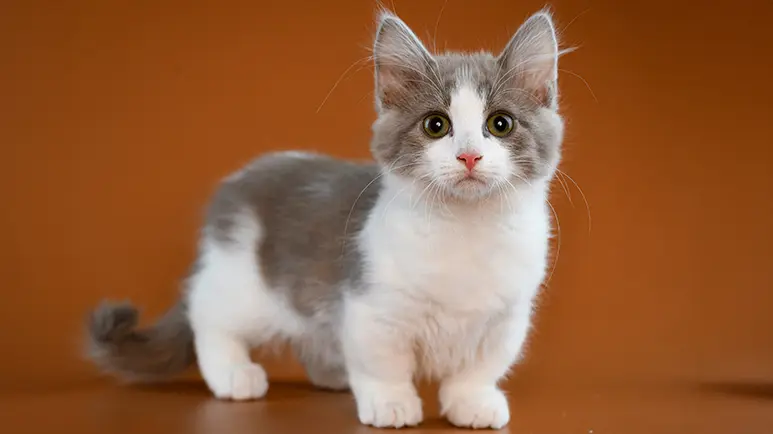Short-Legged Munchkin Cats: Adorable or Unethical?
Munchkin cats are in high demand due to their unusually short legs, but critics suggest the genetic trait, which is a form of dwarfism, may plague the cat with health problems and possibly even make it too painful to jump.

STORY AT-A-GLANCE
- The mutation that causes short legs in cats has been around for decades or more, but munchkin cats have only recently been intentionally bred
- Munchkin cats may be predisposed to osteoarthritis, spinal malformations and rib abnormalities
- Munchkins’ short legs make it difficult, or perhaps too painful, for them to jump like normal cats
Editor's Note: This article is a reprint. It was originally published March 23, 2017.
The Munchkin cat breed, most known for their short legs, has gained considerable fame in recent years, largely due to the abundance of online videos featuring these inarguably adorable felines.
Their popularity is mired in controversy, however, because the genetic mutation that causes their short legs is a form of chondrodystrophism, or dwarfism, and with it can come a high risk of medical problems.
Munchkin cats became a breed recognized by The International Cat Association (TICA) in 2003, but the Cat Fanciers Association (CFA) does not recognize the breed.
History of the Munchkin Breed
Despite their relative newness as a breed, the mutation that causes short legs in cats has been around for a long time. Reports of short-legged cats date back to the 1940s, when a British veterinarian described four generations of what are now known as munchkins.1
Short-legged cats were also reported in Russia, New England and Louisiana, the latter of which being where the modern-day breed came from. According to TICA:2
“In 1983 Sandra [Hochenedel] found a pregnant short-legged female that became the foundation for the breed we call the Munchkin. Sandra named the cat Blackberry.
She gave a male, Toulouse, from one of Blackberry's litters to her friend Kay LaFrance and it is from these two cats that the breed was established using domestic cats as an outcross to ensure a diverse gene pool.”
TICA began tracking the development of the breed in 1994 and revealed that the cats’ short legs stem from a dominant pattern of inheritance, similar to that found in short-legged dog breeds like corgis and dachshunds.
The controversy arises over whether it’s ethical to purposely breed a cat with an extreme physical characteristic, simply for aesthetic purposes — especially one that might put the cat’s health at risk. Corgis and dachshunds, for instance, often have spinal problems as a result of their statures.
TICA claims that “the spine of the cat differs in structure from that of a dog and so the short legs do not result in the spinal problems that sometimes appears in canines.”3 However, other experts beg to differ.
Do Munchkin Cats Avoid Jumping Because It's Too Painful?
In an interview with The Dodo, Dr. Carol Margolis, a veterinarian and lecturer at the University of Pennsylvania School of Veterinary Medicine, disputed the claim that munchkin cats are at no risk of spinal and other health problems.
"As far as what we know, the inappropriate bone formation absolutely leads to abnormal loading, which predisposes them to osteoarthritis. They can have spinal malformations, lordosis and scoliosis … and they can be born with rib abnormalities," she said.4
Their short legs also make it difficult, or perhaps too painful, for munchkins to jump. Margolis said, “Many of the descriptions of these cats is that they cannot jump due to their deformities, but the question is: Is it that they cannot jump, or they will not jump because their deformities are so painful?"5
Veterinarian Dr. Patty Khuly also pointed out in Vetstreet that munchkins aren’t adorable, medically speaking.
She states that most chondrodystrophics suffer from inevitable health issues, such as intervertebral disk disease and cruciate ligament disease.6 Purposely breeding cats with this trait is therefore not only irresponsible but unethical.
Katie Lisnik, director of cat protection and policy at the Humane Society of the United States (HSUS), told The Dodo:7
"Breeding animals for exaggerated physical characteristics, particularly when it compromises overall health, is irresponsible. Breeders should place the long-term health and welfare of their breeding animals and offspring above their efforts to win shows and garner fees."
Munchkin Cats Have Big Personalities
While some people originally seek out munchkins because of their physical characteristics, they fall in love with them because of their personalities. Known for being playful and full of energy, munchkins are also affectionate and typically get along well with other cats, dogs and children.
Unfortunately, their outgoing personalities have created a growing demand for these genetic misfits.
Although they’re not agile jumpers, munchkins are capable of moving at high speeds and zooming around corners with surprising agility. Some also enjoy hiding objects (especially shiny objects) to play with later.
If you’re considering adding a cat to your family, check out your local cat rescue organizations, which have a mix of purebred and mixed-breed cats waiting to find forever homes. Be very wary of obtaining a munchkin cat from a breeder. As noted by the pet adoption site Petfinder:8
“Ironically, the controversy surrounding the breed has contributed to its growing popularity. Because of articles in The Wall Street Journal, People Magazine and other publications, public demand for [m]unchkins has been great, the waiting lists long, and the supply limited.
The sports car of the cat fancy is commanding sports car prices, too, and … disreputable … [breeders may] take advantage of the [m]unchkin's popularity by using unethical breeding practices.”
Sources and References
- 1,2,3 The International Cat Association, Munchkin
- 4,5,7 The Dodo February 1, 2017
- 6 Vetstreet May 16, 2012
- 8 Petfinder, Munchkin Cat








